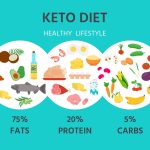Ketosis vs. Ketoacidosis: Understanding the Differences
Ketosis and ketoacidosis are two terms that are often associated with low-carb diets like the ketogenic diet. While they sound similar, it’s crucial to understand that these terms refer to distinct physiological states with vastly different implications for our health. In this blog post, we will explore the differences between ketosis and ketoacidosis, shedding light on their definitions, causes, symptoms, and potential health effects. Understanding these differences is essential for anyone considering or already following a ketogenic diet or managing certain medical conditions.
What is Ketosis?
Ketosis is a natural metabolic state in which the body primarily relies on ketone bodies for fuel instead of glucose. This occurs when carbohydrate intake is restricted, and the body starts breaking down stored fat for energy production. Ketosis is a common physiological response during fasting, low-carb diets, or prolonged exercise. In this state, ketone bodies, such as beta-hydroxybutyrate (BHB), acetoacetate, and acetone, are produced and used as an alternative energy source.
The Ketogenic Diet and Ketosis
The ketogenic diet is a low-carbohydrate, moderate-protein, and high-fat diet designed to induce and maintain ketosis. By drastically reducing carbohydrate intake and increasing fat consumption, the body is forced to shift its primary fuel source to ketones. The ketogenic diet has gained popularity for its potential benefits in weight loss, improved mental clarity, and metabolic health.
What is Ketoacidosis?
Ketoacidosis, on the other hand, is a severe medical condition that occurs when there is an excessive buildup of ketone bodies in the blood, resulting in an acidic environment. Ketoacidosis is most commonly associated with uncontrolled diabetes, particularly in individuals with type 1 diabetes. It can also occur in individuals with type 2 diabetes, but it is much rarer.
Causes and Triggers of Ketoacidosis
Ketoacidosis is primarily caused by a combination of high blood glucose levels (hyperglycemia) and a lack of insulin in the body. When insulin is insufficient or absent, glucose cannot enter cells for energy, leading to increased fat breakdown and the release of ketones. This can result from missed insulin injections, infection, illness, or other factors that disrupt insulin production or utilization.
Symptoms of Ketosis and Ketoacidosis
Ketosis itself is generally considered a safe and natural metabolic state. It is often accompanied by symptoms such as increased thirst, dry mouth, increased urination, and weight loss. These symptoms are typically mild and temporary.
In contrast, ketoacidosis is a medical emergency that requires immediate medical attention. Symptoms of ketoacidosis include high blood glucose levels, excessive thirst, frequent urination, nausea, vomiting, abdominal pain, fruity breath odor, confusion, and in severe cases, unconsciousness. If you experience any of these symptoms, especially if you have diabetes, seek medical help promptly.
https://sugarfreeshop.online/2023/06/23/9-strategies-for-quickly-lowering-blood-sugar-levels/
Health Implications and Management
Ketosis, as experienced in the context of a well-formulated ketogenic diet, is generally considered safe and has been associated with numerous health benefits. However, individuals with certain medical conditions, such as diabetes or metabolic disorders, should approach the ketogenic diet under medical supervision.
In contrast, ketoacidosis is a potentially life-threatening condition that requires immediate medical intervention. People with diabetes should regularly monitor their blood glucose levels, take prescribed medications as directed, and seek prompt medical attention if symptoms of ketoacidosis arise.
Diagnosis and Monitoring
Diagnosing ketosis and ketoacidosis involves different methods. Ketosis can be confirmed through urine, blood, or breath ketone testing, which measures the presence and concentration of ketone bodies. This can be done using over-the-counter testing strips or specialized devices.
Ketoacidosis, on the other hand, is diagnosed through blood tests that measure blood glucose levels, ketone levels, and blood pH. These tests help determine the severity of the condition and guide appropriate medical interventions.
Treatment Approaches
In the context of a well-formulated ketogenic diet, ketosis does not typically require medical intervention. It is a natural response to carbohydrate restriction and can be sustained as long as the diet is followed appropriately.
In the case of ketoacidosis, immediate medical treatment is necessary. Treatment often involves intravenous fluids to rehydrate the body, insulin administration to lower blood glucose levels, and electrolyte replacement to restore balance. Hospitalization may be required for close monitoring and management of the condition.
Prevention and Precautions
To prevent ketoacidosis, individuals with diabetes should closely monitor their blood glucose levels, follow prescribed treatment plans, and seek medical guidance for managing their condition. Regular insulin administration, appropriate diet management, and timely medical care are key in preventing the onset of ketoacidosis.
For those following a ketogenic diet, it is important to maintain a balanced and well-formulated approach. Adequate hydration, electrolyte supplementation, and regular monitoring of ketone levels can help ensure a safe and effective ketogenic experience.
Education and Awareness
Understanding the differences between ketosis and ketoacidosis is crucial for individuals considering a ketogenic diet or those managing diabetes. Education about the signs, symptoms, and appropriate management of both states is vital for making informed decisions about dietary choices, monitoring blood glucose levels, and seeking medical attention when necessary.
By fostering awareness and disseminating accurate information, individuals can navigate the nuances of ketosis and ketoacidosis, enabling them to make educated choices regarding their health and well-being.
In summary, ketosis and ketoacidosis are distinct metabolic states with differing implications for our health. Ketosis is a natural and often desirable state induced by a low-carb or ketogenic diet, where the body primarily uses ketone bodies for energy. On the other hand, ketoacidosis is a dangerous condition associated with uncontrolled diabetes, characterized by high blood glucose levels and an accumulation of ketone bodies.
It’s crucial to differentiate between these two states and be aware of the symptoms and management strategies associated with each. If you have concerns or medical conditions, consult with a healthcare professional before making any dietary changes. Understanding the differences between ketosis and ketoacidosis will help you make informed decisions regarding your health and well-being.












